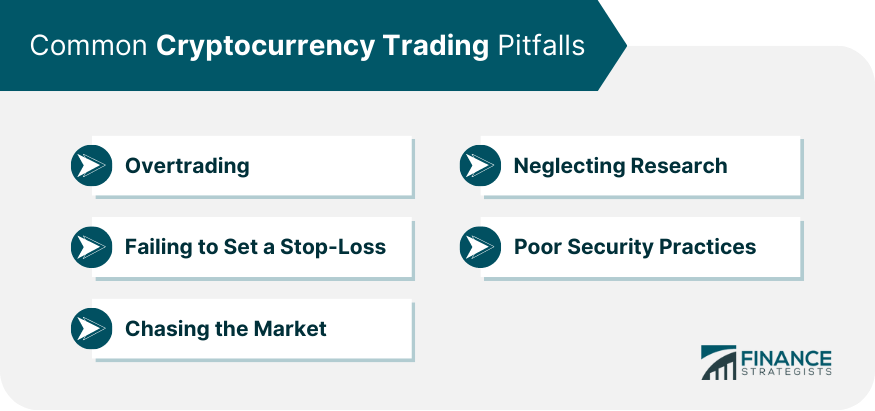Cryptocurrency trading, often simply referred to as "crypto trading," involves the buying, selling, and exchanging of cryptocurrencies. These digital assets operate on decentralized platforms called blockchains, which are distributed ledgers that record all transactions across a network of computers. The primary allure of trading cryptocurrencies is the potential for significant returns, as the crypto market is known for its high volatility. There are various platforms and venues where one can trade cryptocurrencies including centralized exchanges, like Coinbase or Binance. In addition to exchanges, crypto trading can also take place directly between individuals, often facilitated by P2P platforms or over-the-counter (OTC) desks. No matter the method, the essence of crypto trading remains the same: capitalizing on the price movements of digital assets to generate profit. Before diving into cryptocurrency trading, educate yourself about the crypto space, the technology behind it (blockchain), and the specifics of the market. Understand key concepts like decentralization, smart contracts, and tokens. Familiarize yourself with trends, past market behaviors, and prominent figures in the industry. Always be aware that the crypto world is continuously evolving, and constant learning is important. Centralized Exchanges (CEX): Platforms like Binance, Coinbase, and Kraken act as intermediaries in your transactions. Decentralized Exchanges (DEX): Platforms like Uniswap or Sushiswap allow peer-to-peer trades without a central authority. They provide more privacy but might be less intuitive for newcomers. On CEX platforms, you'll: Register: Provide an email and set a password. Ensure using strong and unique passwords for additional security. Verify: Most CEXs require identity verification (KYC - Know Your Customer) due to regulatory measures. This procedure, though sometimes time-consuming, helps in maintaining a safer trading environment by reducing malicious activities. Hardware Wallets: Devices like Ledger Nano S or Trezor keep your cryptocurrencies safe offline. They are immune to online hacks, ensuring that even if exchanges get compromised, your assets remain safe. Software Wallets: Mobile or desktop applications such as Exodus or MyEtherWallet. Always update these wallets to their latest versions to benefit from the latest security enhancements. Deposit fiat currencies (like USD, EUR) using bank transfers, credit cards, or PayPal on some platforms. Each funding method may have different processing times and fees, so choose wisely. Transfer crypto from another wallet if you already own some. Always double-check the receiving address and be cautious of transaction fees. Spot Trading: Buying/selling cryptocurrencies like you'd buy/sell stocks. This is the most straightforward type of trading and is ideal for beginners. Margin Trading: Borrowing money to trade offers higher profit potential but also higher risk. It's crucial to understand the responsibilities and potential pitfalls before engaging. Futures: Contracts to buy/sell a cryptocurrency at a future date at a predetermined price. These can be profitable but require a deeper understanding of market trends. Market Order: Buy/sell instantly at the current market price. Ideal for swift trades but might result in slightly higher fees. Limit Order: Set a specific price at which you want to buy/sell. This gives more control over the entry or exit price but isn't guaranteed to execute. Stop Order: Set a price that, once reached, converts your order into a market order. Useful for risk management, particularly in volatile markets. Technical Analysis: Use charts and indicators to predict future price movements. This involves studying price patterns and using statistical measures to forecast future price actions. Fundamental Analysis: Look at broader factors affecting a cryptocurrency. Factors like technology advancements, team credibility, and market news play a vital role here. Sentiment Analysis: Gauge market participants' mood based on news articles, social media, etc. This helps in understanding the emotional dynamics driving the market. Follow crypto news platforms, forums, and influencers to stay informed. Monitoring market developments allows you to adjust strategies and anticipate potential market shifts. An informed trader can make more calculated decisions and is less likely to be swayed by market rumors or panic. Additionally, by participating in crypto communities, traders can share insights, get feedback, and learn from the experiences of seasoned professionals, further enhancing their trading acumen. With the increasing scrutiny of regulators on crypto transactions, staying compliant has never been more critical. Keep a thorough record of your trades, as this will simplify the tax filing process. Utilizing specialized tax software designed for crypto can help automate this tracking. Ensure you're aware of your country's specific regulations to avoid legal complications. Periodically consulting with a tax services professional familiar with cryptocurrency regulations can provide clarity and help you navigate any changes in tax laws. Never Invest More Than You Can Afford to Lose: This age-old advice remains relevant in the volatile crypto market. Diversify your investments to spread and minimize potential risks. Use Stop-Loss Orders: These can be instrumental in capping potential losses. Regularly review and adjust these as the market evolves. As blockchain technology advances and the regulatory environment evolves, staying at the forefront of knowledge becomes essential. Dedicate time periodically to refresh your knowledge, try out new tools, and adapt to the evolving market dynamics. Engage in webinars, online courses, and community discussions to gain diverse perspectives and stay updated. Always remember, in the fast-paced world of cryptocurrency, knowledge is not just power; it's a tool for risk mitigation and potential profit maximization. Traditionally, wealth management revolved around a combination of equities, bonds, real estate, and other tangible assets. However, the rise of decentralized digital currencies offers a unique blend of potential high returns, liquidity, and diversification. While inherently volatile, cryptocurrencies like Bitcoin, often dubbed "digital gold", are being recognized by many financial experts as a hedge against inflation and macroeconomic uncertainties, similar to precious metals in conventional portfolios. For high-net-worth individuals and institutional investors, crypto assets represent both a speculative opportunity and a chance to diversify portfolios in an increasingly digital-centric global economy. Moreover, the underlying blockchain technology of cryptocurrencies brings about potential innovations in wealth management, from transparent and secure record-keeping to democratizing access to investment opportunities. As the boundaries between traditional finance and the decentralized crypto world blur, wealth managers are tasked with staying informed and adapting their strategies to best serve clients in this digital age. One of the most frequent mistakes new traders make is overtrading — either by trading too frequently or using too much of their capital in a single trade. This often happens due to the fear of missing out (FOMO) or trying to recover previous losses. Overtrading can lead to significant fees and can amplify losses in volatile markets. Not setting a stop-loss can be detrimental. This tool allows traders to set a predetermined price at which their cryptocurrency will automatically sell, preventing larger potential losses in a market downturn. Neglecting this can lead to holding onto a losing position for too long. Trying to catch the peak of a surge or the lowest dip can be a perilous endeavor. Many traders get burned by trying to time the market perfectly, only to find themselves buying at a peak or selling at a trough. It's often more effective to have a consistent strategy than to react impulsively to market swings. Failing to conduct thorough research before making trade decisions is a common pitfall. Some traders rely solely on tips from others or make impulsive decisions based on rumors. Without a solid understanding of the asset being traded or the broader market dynamics, traders are essentially gambling. As the saying goes, "Not your keys, not your crypto." Many traders have lost significant amounts due to hacks, scams, or simple carelessness, like losing access to their wallet. It's crucial to prioritize security by using hardware wallets, enabling two-factor authentication, and being cautious about sharing information online. Crypto trading involves buying, selling, and exchanging cryptocurrencies on decentralized platforms. The appeal lies in high potential returns, yet also elevated risk due to market volatility. To succeed, informed and strategic approaches are vital. Choosing the right platform is crucial, whether centralized exchanges for beginners or decentralized exchanges for privacy. Setting up accounts, securing investments, and funding wisely are essential steps. Understanding spot, margin, and futures trading is key. Developing a strategy using technical, fundamental, and sentiment analysis is crucial. Staying updated prevents being misled by rumors. Risk management involves diversification, stop-loss orders, and continuous learning. As cryptocurrencies gain prominence in wealth management, they offer high returns and diversification. However, pitfalls like overtrading, poor research, and lax security must be avoided. Adapting to this evolving digital landscape is crucial for wealth managers.What Is Crypto Trading?
How to Trade Cryptocurrency
Educate Yourself
Choose the Right Trading Platform
They're user-friendly and ideal for beginners, offering resources and customer support. They are often insured and are more resistant to large-scale hacks.Set-up an Account
Secure Your Investments
Fund Your Account
Understand the Market
Make a Trade
Develop a Strategy
Stay Updated
Understand the Tax Implications
Manage Risks
Continuous Learning

Role of Cryptocurrency in Wealth Management
Common Cryptocurrency Trading Pitfalls
Overtrading
Failing to Set a Stop-Loss
Chasing the Market
Neglecting Research
Poor Security Practices

Conclusion
Cryptocurrency Trading FAQs
Cryptocurrency trading involves buying, selling, and exchanging digital assets like Bitcoin using online platforms.
Traders use specialized platforms to exchange cryptocurrencies based on market prices, aiming to profit from price fluctuations.
Cryptocurrency trading carries risks due to market volatility. Prices can change rapidly, leading to potential gains or losses.
Beginners can start with user-friendly centralized exchanges like Coinbase, where they can create accounts, deposit funds, and trade cryptocurrencies.
Traders can employ technical analysis, studying charts and patterns, or fundamental analysis, considering technology and market news, to make informed trading decisions in the cryptocurrency market.
True Tamplin is a published author, public speaker, CEO of UpDigital, and founder of Finance Strategists.
True is a Certified Educator in Personal Finance (CEPF®), author of The Handy Financial Ratios Guide, a member of the Society for Advancing Business Editing and Writing, contributes to his financial education site, Finance Strategists, and has spoken to various financial communities such as the CFA Institute, as well as university students like his Alma mater, Biola University, where he received a bachelor of science in business and data analytics.
To learn more about True, visit his personal website or view his author profiles on Amazon, Nasdaq and Forbes.











